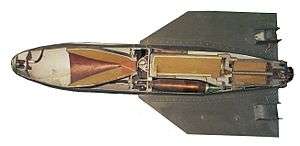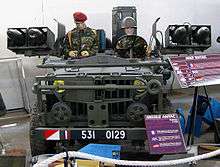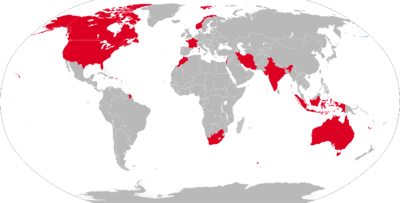ENTAC
ENTAC (ENgin Téléguidé Anti-Char) or MGM-32A was a French MCLOS wire-guided Anti-tank missile. Developed in the early 1950s, the weapon entered service with the French army in 1957. Production ended in 1974 after approximately 140,000 had been built.
| ENTAC | |
|---|---|
 Cut-away of an early Model 56 ENTAC missile | |
| Type | Anti-tank missile |
| Place of origin | France |
| Service history | |
| In service | 1957 |
| Used by | (see below) |
| Production history | |
| Designed | 1950s |
| Manufacturer | DTAT & Aerospatiale |
| Produced | 1957-1974 |
| No. built | 140,000 |
| Specifications | |
| Mass | 12.2 kg |
| Length | 820 mm |
| Diameter | 152 mm |
| Warhead | 4 kg Hollow-charge capable of piercing 650 mm of RHA |
Detonation mechanism | nose fuse |
| Engine | combination solid booster and sustainer |
| Wingspan | 375 mm |
Operational range | 400 m - 2 km |
| Maximum speed | 100 m/s |
Guidance system | MCLOS wire |
Steering system | trailing edge wing spoilers |
Launch platform | individual |
| External image | |
|---|---|
| DTAT/Aerospatiale ENTAC | |
Development
The missile was developed by the French Government agency - DTAT (Direction Technique des Armements Terrestres) at the same time as the private industry SS.10. Development time for the ENTAC was longer than the SS.10, so it did not enter service until 1957. It proved to be a great improvement over the SS.10, which had entered production five years earlier. Once fully developed and tested, production of the ENTAC was given to the firm of Aerospatiale. The ENTAC was designed to be a man-portable weapon or operated from a small vehicle like the Jeep, replacing the Nord SS.10 in French service.
Design

.jpg)
The missile is launched from a simple metal box, which is connected to an operator station. An individual operator station can control up to 10 launcher boxes. The operator manually steers the missile by means of a small joystick. These course corrections are transmitted to the missile via a thin set of wires that trail behind the missile - see MCLOS. Like many early ATGMs, the missile had a large minimum range (see AT-3 Sagger) due to the time it took to get up to flight speed and come under operator control.
Operational history
Australia
Used from 1964 until 1982.[1]
France
The missile first entered service in 1957. The ENTAC may have been used by France in small numbers during the 1960s and 1970s on peacekeeping operations.[2]
India
ENTAC missiles entered service in 1968 after being ordered a year prior. They may have been used against Pakistani tanks during the 1971 war.[3]
Iran
Ordered in 1966 and delivered from 1966-1969. It remained in service after the 1979 Iranian revolution and was used against Iraqi tanks during the 1980-88 war.[4]
Israel
Entered service in 1963 after being ordered the year before. It is likely that they were used during the 1967 Six-Day War against Arab tanks.
Lebanon
Ordered in 1966 and entered service in 1967. These were deployed during the Lebanese Civil War and was used in street fighting, particularly during the early 1980s.[2]
South Africa
French-made missiles were in the inventory, alongside locally manufactured licence-built missiles.[5] Having acquired some 500 examples by 1969,[6] expeditionary units of the South African Defence Force first deployed ENTACs against People's Armed Forces for the Liberation of Angola (FAPLA) and Cuban military advisers during Operation Savannah. The system was often mounted on unarmoured Land Rovers.[7] South African servicemen destroyed at least one FAPLA mortar position with their missiles in September 1975.[7] Two Angolan T-54/55 tanks were also eliminated by ENTAC crews, working in concert with Eland and Ratel-90 armoured cars, during Operation Askari, 1984.[2]
United States
The US army purchased the Model 58 ENTAC with an improved warhead to replace the Nord SS.10 (or MGM-21A). It was designed to be an interim weapon, used as the BGM-71 TOW was being developed. The first missiles were deployed in 1963, that year the missile received the US designation MGM-32A. In US service the missile was based on the M151 Jeep and issued to the Anti-tank Platoon of the Heavy Weapons Company. In Korea (7th ID @ 1st CAV) it replaced the Scorpion tracked AT vehicle, a 90MM SP Gun which could not climb the hilly terrain as easily as the Jeep. Using extended cables missiles could be fired from defilade. The missile was phased out between 1968 and 1969, being replaced with the more advanced BGM-71 TOW. It was used in the Vietnam War against fortified infantry positions, but not enemy tanks. It was fired by the 14th Infantry Regiment, amongst others.[2]
Models
- ENTAC / MGM-32A
Operators

Former operators
.svg.png)
.svg.png)
.svg.png)








.svg.png)


Notes
- Australian Government site Archived 8 February 2010 at the Wayback Machine
- Henson, Jason W."MGM-32 Entac ATGM." Archived 2 October 2011 at the Wayback Machine "Harpoon Head Quarters". Retrieved: 24 December 2009.
- Amin, Agha Humayun, "The Battle of Chamb-1971" "Defence Journal", September 1999. Retrieved: 24 December 2009.
- "Flightglobal", 1986. Retrieved: 24 December 2009.
- Moukambi, Victor (December 2008). RELATIONS BETWEEN SOUTH AFRICA AND FRANCE WITH SPECIAL REFERENCE TO MILITARY MATTERS, 1960-1990 (PDF) (Doctoral dissertation thesis). Stellenbosch: Military Science, Stellenbosch University. pp. 181–2. Retrieved 27 April 2017.
manufacturing licences for ENTAC missiles, 400 kg aircraft bombs and [STRIM] anti-tank rifle grenades were also granted to South Africans. Source: DOD, SANDF Documentation Centre, Pretoria. File No. Map 70/15 Vol. 1, Licence agreements, Annexure 2 to MAP/70/15 dated December 1966. Subject: Armament policy
- SIPRI Arms Transfers Database "Stockholm International Peace Research Institute". Retrieved: 24 December 2009.
- Steenkamp, Willem (2006) [1985]. Borderstrike! South Africa into Angola. 1975-1980 (3rd ed.). Durban, South Africa: Just Done Productions Publishing (published 1 March 2006). pp. 38–200. ISBN 978-1-920169-00-8. Archived from the original on 6 October 2014. Retrieved 14 October 2014.
- Cecil, Michael. "REMEMBER WHEN.... WE GOT ATGWS?" "OnTarget", December 2007. Retrieved: 24 December 2009.
- "Missile Forces of the World." "Flightglobal", 1977. Retrieved: 24 December 2009.
- Zarzecki, Thomas W., Arms diffusion: the spread of military innovations in the international system, Routledge, c. 2002, ISBN 978-0-415-93514-2
- Nortje, Piet (2003). 32 Battalion. Zebra Press. p. 98. ISBN 978-1-86872-914-2.